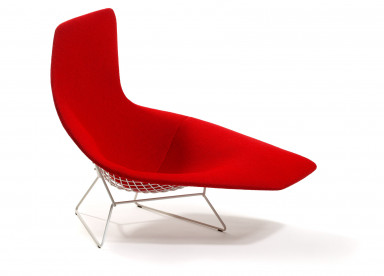


Harry Bertoia was a complete and gifted artist. Knoll historian Brian Lutz once said “Bertoia’s paintings were better than his sculptures. And his sculptures were better than his furniture. And his furniture was absolutely brilliant.”
After studying at the Detroit Technical High School and the Detroit School of Arts and Crafts, Harry Bertoia opened his own metal workshop at Cranbrook where he taught jewelry design and metal work. In 1946 he moved to California to help fellow Cranbrook alumnus Charles Eames develop methods of laminating and bending plywood. Bertoia’s contributions to the famous Eames chairs were crucial if not not well known.
On the suggestion of Herbert Matter, who had worked alongside Eames and Bertoia, Florence and Hans traveled to California and encouraged Bertoia to move east and set up his own metal shop in a corner of Knoll’s production facility. Having studied with Bertoia at Cranbrook, Florence was sure that he would produce something extraordinary if given the time and space to experiment.
"I went around and discovered, quite soon, that I was not the man to do research. My feeling was that had to come from an inward direction. I began to rely once more on my own body. I began to think in terms of what I would like as a chair. It started very slowly…I came into rod or wire, whether bent of straight. I seemed to find myself at home. It was logical to make an attempt utilising the wire."
Characteristic of the early environment at Knoll, Hans and Florence never demanded that Bertoia design furniture, but instead encouraged him to explore whatever he liked. They simply asked that if he arrived at something interesting, to show them. Needless to say, Harry Bertoia arrived at something outstanding. His iconic wire furniture collection, introduced in 1952, is recognized worldwide as one of the great achievements of 20th century furniture design.
While he only designed one series of furniture, Bertoia continued to be involved in the Knoll story by providing sculptures and architectural installations for Planning Unit projects. He designed an altar for the MIT Chapel, designed by Eero Saarinen. Bertoia spent the next 25 years of his life experimenting with light, sound and volume through sculptures, paintings and architectural installations.
1956 - AIA Craftsmanship Award;
1968 - Critic's Award